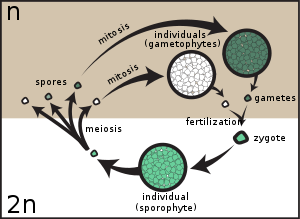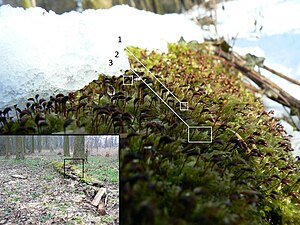

In biology, a spore is a unit of sexual (in fungi) or asexual reproduction that may be adapted for dispersal and for survival, often for extended periods of time, in unfavourable conditions.[1] Spores form part of the life cycles of many plants, algae, fungi and protozoa.[2] They were thought to have appeared as early as the mid-late Ordovician period as an adaptation of early land plants.[3]
Bacterial spores are not part of a sexual cycle, but are resistant structures used for survival under unfavourable conditions.[4] Myxozoan spores release amoeboid infectious germs ("amoebulae") into their hosts for parasitic infection, but also reproduce within the hosts through the pairing of two nuclei within the plasmodium, which develops from the amoebula.[5]
In plants, spores are usually haploid and unicellular and are produced by meiosis in the sporangium of a diploid sporophyte. In some rare cases, diploid spore is also produced in some algae, or fungi.[6] Under favourable conditions, the spore can develop into a new organism using mitotic division, producing a multicellular gametophyte, which eventually goes on to produce gametes. Two gametes fuse to form a zygote, which develops into a new sporophyte. This cycle is known as alternation of generations.
The spores of seed plants are produced internally, and the megaspores (formed within the ovules) and the microspores are involved in the formation of more complex structures that form the dispersal units, the seeds and pollen grains.
- ^ Setlow, Peter; Johnson, Eric A. (30 April 2014), Doyle, Michael P.; Buchanan, Robert L. (eds.), "Spores and Their Significance", Food Microbiology, Washington, DC, USA: ASM Press, pp. 45–79, doi:10.1128/9781555818463.ch3, ISBN 978-1-68367-058-2, retrieved 13 December 2023
- ^ "Tree of Life Web Project". Archived from the original on 5 February 2018. Retrieved 5 February 2018.
- ^ Wellman, C. H.; Gray, J. (29 June 2000). "The microfossil record of early land plants". Philosophical Transactions of the Royal Society of London. Series B, Biological Sciences. 355 (1398): 717–731, discussion 731–732. doi:10.1098/rstb.2000.0612. ISSN 0962-8436. PMC 1692785. PMID 10905606.
- ^ Abel-Santos, Ernesto (2012). Bacterial spores: current research and applications. Norfolk: Caister academic press. ISBN 978-1-908230-00-3.
- ^ Ivan Fiala (10 July 2008). "Myxozoa". Tree of Life Web Project. Archived from the original on 16 February 2015. Retrieved 14 January 2014.
Myxospores consist of several cells, which are transformed to shell valves, nematocyst-like polar capsules with coiled extrudible polar filaments and amoeboid infective germs.
- ^ "Diploid Spore - an overview | ScienceDirect Topics". www.sciencedirect.com. Archived from the original on 13 December 2023. Retrieved 13 December 2023.